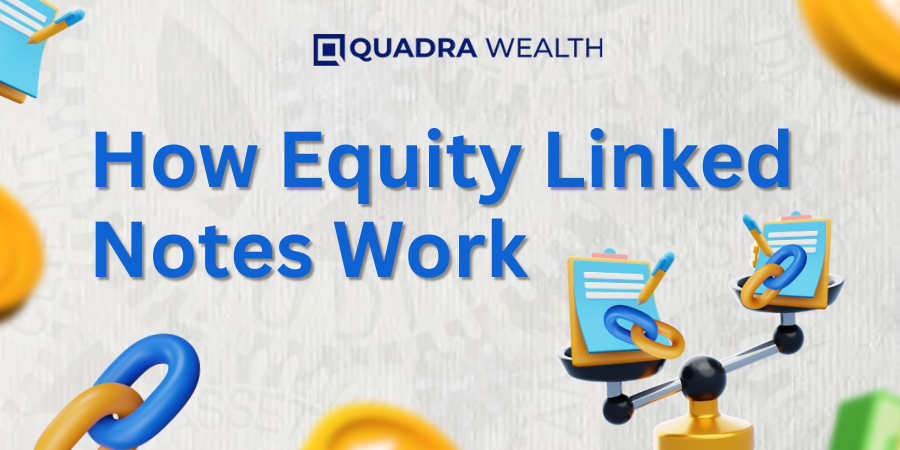Equity-linked notes (ELNs) are structured financial products that incorporate the characteristics of both bonds and equity options, with returns tied to the performance of an underlying asset.
Investors who want to have a diversified portfolio must have an idea about equity-linked notes. In addition to giving investors exposure to equity markets, these structured products serve as their primary safeguard against downside risk. Even though ELNs—also known as market-linked notes, equity-linked securities, or structured notes—can be complex, understanding how they operate is important while making wise investment choices.
ELNs also offer investors exposure and a way to control market volatility while pursuing new opportunities for their investment strategy.
In this blog, we’ll break down how equity linked notes work, explain what ELNs are, and the key factors influencing their performance. By the end, you’ll have a clearer picture of how these notes provide investment options in various market conditions.
Understanding Equity-Linked Notes (ELN)?
ELNs are a type of structured note. Financial institutions issue these and are debt instruments that are usually linked to the appreciation of the underlying stock or equity index. The ELN’s principal amount is repaid at maturity, and returns depend upon how well the underlying asset performs.
Equity-linked notes offer investors fixed interest rates or coupons for a specific time, usually for one to ten years. Through participation in the appreciation of the underlying asset as well as downside protection, ELNs offer investors who are looking for potential upside.
There are several types of ELNs, including yield-enhanced notes, coupon-paying notes, and principal protection notes.
How Do Equity Linked Structured Products Work?
Curious about how equity-linked notes work? Let’s explore.
Equity-linked structured products are generated by combining financial contracts referred to as derivatives. These are financial instruments that derive value from underlying assets like stocks or indexes, with fixed-income instruments like bonds.
With this combination, ELNs provide investors to control their risk while getting exposure to the equity market. Due to their structured nature, these products have predetermined terms and conditions, based on the investor’s preferences, and may include built-in loss protection or return caps.
The Role of Derivatives in Equity-Linked Notes
An essential element of equity-linked structured note products is derivatives. These financial instruments are utilized to impact the possible returns and risks of the ELN. These derivative components are linked to the value of an underlying asset, such as a stock or bond.
Market Exposure
With derivatives, investors can potentially get increased returns or losses based on the performance of the underlying equity asset. For example, a structured product that uses options might offer higher potential returns than simply investing directly in the underlying stock.
Protection and Payouts
Derivatives also enable structured products to have features like custom payout structures that are designed to function in various market scenarios or downside protection, which can limit potential losses. However, it’s important to consider that employing derivatives can come with certain additional risks, like higher sensitivity to market changes.
Suggested Reads: The Future of Derivatives and Structured Products: Trends and Innovations
The Relationship Between Underlying Assets and Returns
The relationship between the underlying assets and returns is tied to the performance of equity-linked structured products. Returns from these products are usually linked with the performance of certain assets, like stocks or bonds. This means the outcome may differ greatly based on how well the underlying asset performs.
Performance Linked Results
The performance of an underlying asset, such as an index or a group of assets, is usually linked to the return associated with an ELN. If the performance of the underlying asset is strong, an investor who chooses to invest in ELNs could see higher returns. On the contrary, the investor may receive smaller returns if the underlying asset performs badly.
Risk Associated
Like any equity investment, ELNs come with significant risks. The credit risk of the issuer is the primary concern for risk-averse investors as there’s a possibility that they could lose their entire investment if the issuer goes bankrupt. The market’s performance carries some risk as well because the underlying asset may perform poorly. Furthermore, as ELNs involve a high level of risk, it’s important for investors to thoroughly understand the terms and conditions before making a financial commitment.
Related: Understanding the Benefits and Risks of Equity Structured Notes
Image Courtesy: https://www.dbs.com
Image Courtesy: https://www.dbs.com
How ELNs Work: Practical Insights
Imagine you invest $1,000 in a five-year ELN. The issuer might use $800 to buy a bond that matures in five years with a 4.5% yield, while the remaining $200 is invested in call options on the S&P 500. If the options don’t gain value, you still get your $1,000 back. But if the S&P 500 performs well, the returns from the options are added to the original $1,000, giving you a higher interest rate.
Additionally, ELNs have a “strike” price that is settled less than the market price. For instance, with a 95% strike price, the investor gets the stock at this discounted price if the stock price falls below 95% of its initial value. The investor gets their entire principal back if the stock remains above the strike price. The difference between the principal and the initial investment represents the yield.
Bottom Line – Potential Investment Option
Equity-linked notes are a unique investment product that combines the upside potential of stocks with the certainty of bonds. By understanding how equity-linked notes work, involving how derivatives work as well as the relationship between underlying assets and returns, investors can make more informed decisions.
ELNs offer a financial instrument that helps to enhance a diversified portfolio. As with any investment product, it’s important to ensure that ELNs match your objectives and risk tolerance, do your research, and speak with financial experts. With the right approach, ELNs can be a valuable addition to your investment strategy.






